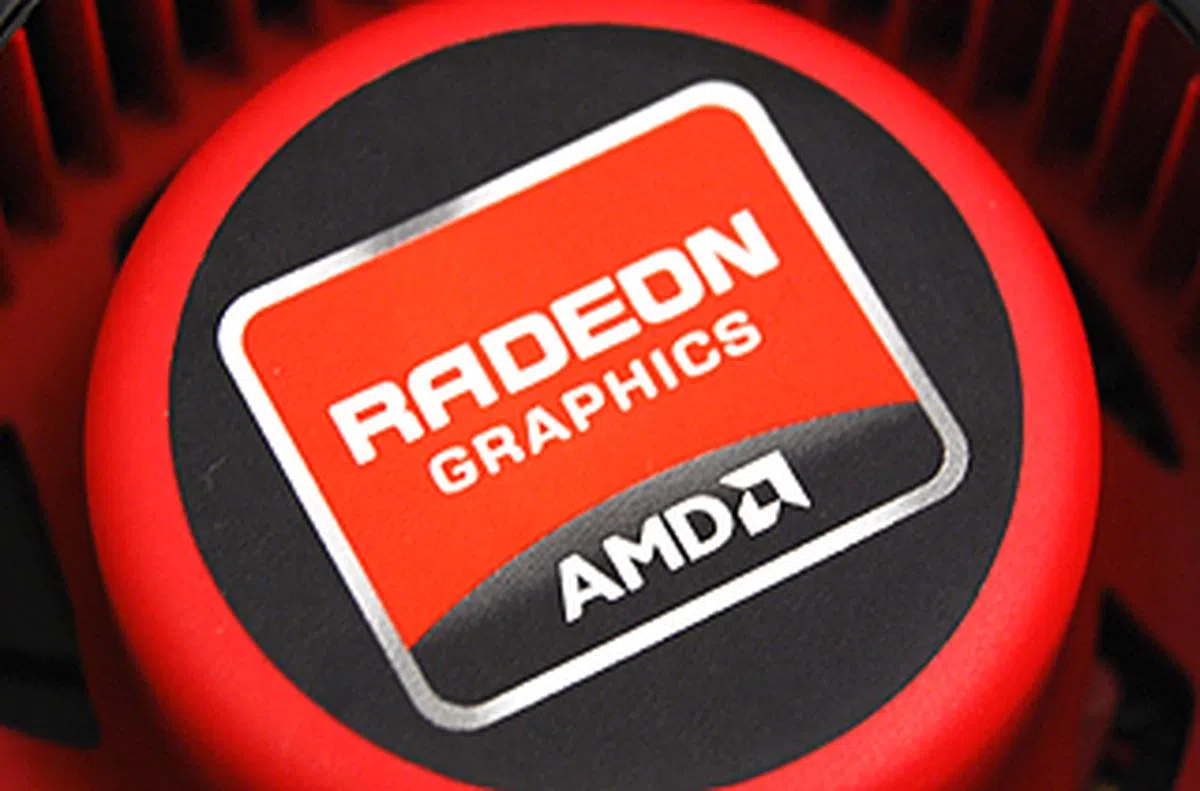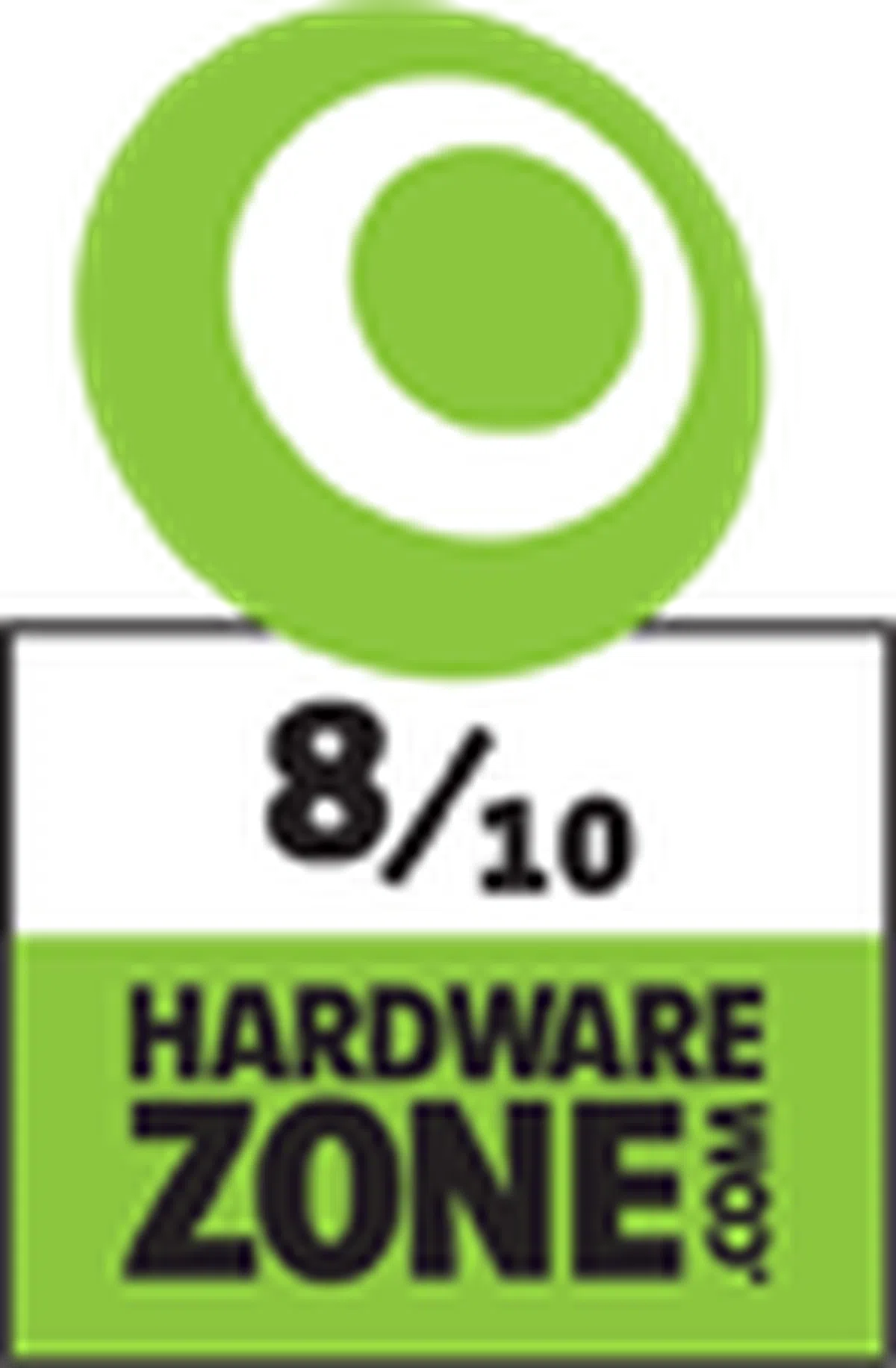AMD Radeon HD 6970 & HD 6950 - Cayman Arrives!
The highly anticipated high-end Radeon HD 6970 and HD 6950 is finally here. We find out if it can reclaim the title of fastest single GPU from NVIDIA.
By Kenny Yeo -
AMD's Single GPU King Arrives
AMD’s new generation Northern Islands class GPUs were officially launched in October with the two "Barts"-powered Radeon HD 6870 and HD 6850. And although Northern Islands was not a major step forwards for AMD - seeing that they only made small changes to the Evergreen architecture - the two mainstream parts were still very well received for their excellent combination of performance, efficiency, features and price. To get up to speed on what Northern Islands bring to the table, check out our earlier review here.
Northern Islands also marked a significant change in the way the cards are marketed. For one, the ATI brand has been killed off and replaced by AMD. And secondly, the nomenclature of the Northern Islands line-up differs substantially from past editions. Previously in Evergreen, the 5800 series represented the company’s premium single GPU cards, while the 5900 series represented the company’s single dual-GPU card, which also happens to be their most powerful offering. In Northern Islands, that has been tweaked a little as the 6800 series now refers only to the company’s higher-end mainstream offerings. While the most powerful single GPU Northern Islands cards will instead be bumped up into the Radeon HD 6900 series. Perhaps a sign of the "X2" nomenclature coming back for future dual-GPU editions?

AMD's fastest single GPU cards are finally here and we can't wait to see how they'll perform.
Speaking of the Radeon HD 6900 series, it is finally here. Initially expected to launch in mid-November, AMD decided to delay the launch of the new high-end Northern Islands parts by a month citing continuing strong demand for the Radeon HD 5800 and HD 5900 series. However, many believed that the Radeon HD 6900 series was really delayed by yield issues. And in the past month, NVIDIA has stepped up their efforts and introduced two super-quick cards, the and . The two new SKUs are spanking fast and it'll be interesting to see how AMD's latest will match up against them.
Codenamed Cayman, the new Radeon HD 6900 series is launched with two cards, the Radeon HD 6970 and HD 6950, both of which are expected to replace the old Radeon HD 5870 flagship single GPU card and features more improvements and optimizations compared to Barts. In a nutshell, these two new cards will be new premium, fastest single GPU offerings from AMD.
But before we delve further into AMD’s latest, here’s a quick look at how the new Radeons stack up against the competition.
Model | AMDRadeon HD6970 | AMDRadeon HD6950 | NVIDIAGeForce GTX570 | NVIDIAGeForce GTX 580 | NVIDIAGeForceGTX 480 | ATIRadeon HD5970 | AMDRadeon HD 6870 | ATI Radeon HD 5870 |
Core Code | Cayman XT | Cayman PRO | GF110 | GF110 | GF100 | Hemlock | Barts XT | Cypress XT |
Transistor Count | 2640 million | 2640 million | 3000 million | 3000 million | 3200 million | 4300million | 1700 million | 2150 million |
Manufacturing Process | 40nm | 40nm | 40nm | 40nm | 40nm | 40nm | 40nm | 40nm |
Core Clock | 880MHz | 800MHz | 732MHz | 772MHz | 701MHz | 725MHz | 900MHz | 850MHz |
Stream Processors | 1536 Stream processing units | 1408 Stream Processing units | 480 Stream Processors | 512 Stream Processors | 480 Stream Processors | 3200 Stream processing units | 1120 Stream processing units | 1600 Stream processing units |
Stream Processor Clock | 880MHz | 800MHz | 1464MHz | 1544MHz | 1401MHz | 725MHz | 900MHz | 850MHz |
Texture Mapping Units (TMU) or Texture Filtering (TF) units | 96 | 88 | 60 | 64 | 60 | 160 | 56 | 80 |
Raster Operator units (ROP) | 32 | 32 | 40 | 48 | 48 | 64 | 32 | 32 |
Memory Clock | 5500MHz GDDR5 | 5000MHz GDDR5 | 3800MHz GDDR5 | 4008MHz GDDR5 | 3696MHz GDDR5 | 4000MHz GDDR5 | 4200MHz GDDR5 | 4800MHz GDDR5 |
DDR Memory Bus | 256-bit | 256-bit | 320-bit | 384-bit | 384-bit | 256-bit | 256-bit | 256-bit |
Memory Bandwidth | 176.0GB/s | 160.0GB/s | 152GB/s | 192.4GB/s | 177.4GB/s | 256GB/s | 134.4GB/s | 153.6GB/s |
PCI Express Interface | PCIe ver 2.0 x16 | PCIe ver 2.0 x 16 | PCIe ver 2.0 x16 | PCIe ver 2.0 x16 | PCIe ver 2.0 x16 | PCIe ver 2.0 x16 | PCIe ver 2.0 x16 | PCIe ver 2.0 x16 |
Molex Power Connectors | 1 x 6-pin, 1 x 8-pin | 2 x 6-pin | 2 x 6-pin | 1 x 6-pin, 1 x 8-pin | 1 x 6-pin, 1 x 8-pin | 1 x 6-pin, 1 x 8-pin | 2 x 6-pin | 2 x 6-pin |
Multi GPU Technology | CrossFireX | CrossFireX | SLI | SLI | SLI | CrossFireX | CrossFireX | CrossFireX |
DVI Output Support | 1 x Dual-Link, 1 x Single-Link | 1 x Dual-Link, 1 x Single-Link | 2 x Dual-Link | 2 xDual-Link | 2 x Dual-Link | 2 x Dual-Link | 1 x Dual-Link, 1 x Single-Link | 2 x Dual-Link |
HDMI | 1 | 1 | 1 (mini-HDMI) | 1 (mini-HDMI) | 1 (mini-HDMI) | 1 | 1 | 1 |
DisplayPort | 2 (DisplayPort 1.2) | 2 (DisplayPort 1.2) | None | None | None | 1 | 2 (DisplayPort 1.2) | 1 |
HDCP Output Support | Yes | Yes | Yes | Yes | Yes | Yes | Yes | Yes |
Street Price | Launch price: US$369 | Launch Price: US$299 | ~US$349 | ~US$529 | ~US$429 | ~US$500 | US$239 | ~US$360 |
Introducing the Radeon HD 6970 and HD 6950
Architecturally, Cayman features a few more upgrades from Barts. One of the key changes in Cayman is that the chip now boasts dual graphics engines for more optimized usage and execution of graphics processing. On top of that, it also has a further improved tessellation unit, upgraded render back-ends, and a new VLIW4 core design. Overall, these optimizations lets the new Radeon HD 6900 do more per clock, which improves overall performance per core, and also drastically improves tessellation and anti-aliasing performance. In fact, AMD claims that the new the Radeon HD 6970 has three times the tessellation capability of the old Radeon HD 5870. This is a much welcome improvement seeing that even AMD’s latest Radeon HD 6870 and HD 6850 have mostly trailed NVIDIA’s Fermi cards when it came to tessellation-intensive application.

Barts introduced to Northern Islands two dispatch processors, with Cayman, each dispatch processor gets its own graphics engine which has an improved 8th generation tessellation unit.
AMD PowerTune
One of the new features of the Cayman cards is AMD's PowerTune Technology, which helps the card achieve better performance by dynamically adjusting the card's clock speeds during run-time based on an internally calculated GPU power assessment. Essentially, this means that instead of limiting the card's clock speeds to ensure that it operate within its TDP envelop, the Cayman cards are clever enough to adjust and even overclock the card if it sees that it is still operating well within its TDP envelop. Unfortunately, we couldn't give this option a go as PowerTune option did not show up on our version of Catalyst. As such, we'll probably delve into this topic on another occasion to highlight the extent of its merits.
EQAA
The Radeon HD 6900 series also introduces to us EQAA, a new anti-aliasing option. It improves graphics quality by doubling the number of coverage sample per pixel while keeping the number of color, depth, and stencil samples constant. This offers smoothing of aliased edges with little penalty to video memory and at a minimal performance cost. This can be enabled using AMD's Catalyst software.
Technical Specifications
If you are interested in numbers, the Radeon HD 6970 has 24 SIMD engines, 1536 stream processing units and runs at a considerable 880MHz at the core. That’s slightly lesser than the 1600 stream processing units that the old Radeon HD 5870 has, but then again, the cores are now more efficient than before, so it is unfair to compare them outright. To add, the Radeon HD 6970 also has a generous 2GB of framebuffer which runs at staggering 5500MHz GDDR5. Memory interface continues to be limited to 256-bits wide, but thanks to the ultra-high memory clock speeds, effective memory bandwidth is now a whopping 176GB/s.
Not to be outdone, the Radeon HD 6950 has 22 SIMD engines and 1408 stream processing units - lesser than the Radeon HD 6970 but still beefy nonetheless. The Radeon HD 6950 also has a large 2GB framebuffer with a 256-bit wide memory interface, but it will run at slightly lower clock speeds - 800MHz at the core and 5000MHz DDR at the memory, to be exact.
Here are some photos of the cards.

The new Cayman cards are massive, measuring slightly over 10.5 inches and tipping the scales at 1kg a piece.

The Radeon HD 6970 and HD 6950 will both have two DVI ports, a single full-sized HDMI port, and two DisplayPort 1.2 ports.

Both the Radeon HD 6970 and HD 6950 will have two CrossFireX connectors, meaing a 4-way CrossFireX configuration is possible. The new Radeons also come with dual BIOS and the little switch to left lets users toggle between the BIOS.

The two cards are similar in many ways, but the Radeon HD 6970 requires botha 6 and 8-pin PCIe power connector for power. AMD recommends a PSU rated for at least 600W for optimal operation.

The Radeon HD 6950, on the other hand, gets its power via two 6-pin PCIe power connectors. AMD recommends pairing the card with a PSU rated for at least 550W.
Test Setup
To evaluate the Radeon HD 6970 and HD 6850, we’ll be using our X58 system which has the following specifications:
- Intel Core i7-975 (3.33GHz)
- Gigabyte GA-EX58-UD4P motherboard
- 3 x 1GB DDR3-1333 G.Skill memory in triple channel mode
- Seagate 7200.10 200GB SATA hard drive
- Windows 7 Ultimate
Obviously, we are expecting the new Radeon HD 6970 and HD 6950 to beat the older HD 5870, but we are also interested to see if it’ll come close to the dual-GPU Radeon HD 5970. Also, we are interested to see how the new Radeons will match up against NVIDIA’s new super-quick GeForce GTX 580 and GTX 570.
Here is the full list of cards tested and driver versions used:
- AMD Radeon HD 6970 2GB GDDR5 (Catalyst 10.11)
- AMD Radeon HD 6950 2GB GDDR5 (Catalyst 10.11)
- ATI Radeon HD 5970 2GB GDDR5 (Catalyst 10.9)
- AMD Radeon HD 6870 1GB GDDR5 (Catalyst 10.10)
- ATI Radeon HD 5870 1GB GDDR5 (Catalyst 10.9)
- NVIDIA GeForce GTX 580 1560MB GDDR5 (ForceWare 262.99)
- NVIDIA GeForce GTX 570 1280MB GDDR5 (ForceWare 263.09)
- NVIDIA GeForce GTX 480 1560MB GDDR5 (ForceWare 260.89)
- NVIDIA GeForce GTX 470 1280MB GDDR5 (ForceWare 263.09)
The list of benchmarks used are as follows:
- Futuremark 3DMark 11
- Futuremark 3DMark Vantage
- Crysis Warhead
- Far Cry 2
- Warhammer: Dawn of War 2
- Battlefield Bad Company 2
- “Heaven" from Unigine v2.1
- S.T.A.L.K.E.R.: Call of Pripyat
3DMark 11 & 3Mark Vantage Results
The long awaited 3DMark 11 benchmarking software was officially launched just about a week ago and it makes extensive use of all of DirectX 11 features such as tessellation, compute shaders and multi-threading. It’s early days yet for this benchmark and we couldn’t get the NVIDIA cards to successfully complete a run, but here’s how the latest Northern Islands cards measure up against one another.

On to the trusty 3DMark Vantage and we noticed that the new Radeon HD 6970 was unable to outscore the GeForce GTX 570. In fact, if we had to nitpick, we would say that the GeForce GTX 570 did marginally better.
However, the Radeon HD 6970 was did score substantially better than the Radeon HD 6950, by about 10% overall. The Radeon HD 6950, in turn, achieved roughly the same scores as the old HD 5870, which also happened to be 15% or so greater than the Radeon HD 6870.

Crysis Warhead & Far Cry 2 Results
Moving on to real-world gaming applications with Crysis Warhead, we noted that the Radeon HD 6970 was slightly quicker than the GeForce GTX 570, especially when anti-aliasing was enabled, no doubt due its significantly larger framebuffer. But even so, the difference was very slight. This also meant that Radeon HD 6970 was some ways off from challenging the mighty GeForce GTX 580.
On the other hand, the Radeon HD 6950 just only a fraction quicker than the old Radeon HD 5870, and again, the difference was most apparent with anti-aliasing enabled. Clearly, the improved anti-aliasing engine and large framebuffer of the Cayman cards helped them in these scenarios.


NVIDIA cards have traditionally performed well on Far Cry 2 so perhaps it’s not surprising to see the Radeon HD 6970 losing out to the GeForce GTX 570. Compared to the Radeon HD 6950, the HD 6970 was about 11% quicker, whereas the Radeon HD 6950 continued to outperform the old Radeon HD 5870 by a slight margin.


Dawn of War 2 and Battlefield Bad Company 2 Results
Dawn of War 2 has always been closely contested, and all the cards here recorded very comparable frame rates. However, the new Radeon HD 6970 and HD 6950 did pull ahead when we came to the most intensive setting of 1920 x 1200 with anti-aliasing enabled. This is no doubt due to their generous 2GB framebuffers as well as the more efficient anti-aliasing engines on the new Caymen cards.

Battlefield Bad Company 2 is one of the hottest DirectX 11 titles this year and it makes use of tessellation which is an area where the Radeons are weak at. And although the new Radeon HD 6970 and HD 6950 claim to have improved tessellation performance, the Radeon HD 6970 is only a tad quicker than the old Radeon HD 5870, whereas the HD 6950 finds itself trailing the HD 5870 by a couple of frames.
Compared to the GeForce GTX 570, the Radeon HD 6970 found itself trailing by a considerable 18%, but if you turn the page and look at the results from Unigine, the difference between the two isn’t so great, so perhaps this is an issue with drivers more than anything else. We’ll be looking at this benchmark closely in future testing.

Unigine "Heaven" 2.1 Results
Unigine is an benchmark that stresses tessellation performance more than anything else and here we can see that AMD has made significant improvements to the way the new Radeon HD 6970 and HD 6950 handle tessellation operations. The Radeon HD 6970 is a good 10% quicker than the Radeon HD 6950, but the HD 6950 is no slouch seeing that it is around a whopping 40% quicker than the HD 5870.
The Radeon HD 6970 was also able to match the GeForce GTX 570 with anti-aliasing disabled. Enable anti-aliasing, however, and it starts to build a small advantage and comes to close to challenging even the GeForce GTX 580 and the most intensive run of 1920 x 1200 with 8x anti-aliasing enabled. Judging from the numbers here, it seems that AMD has greatly improved the tessellation performance of their newest cards.
When we reverted to DirectX10, however, we noticed the Radeon HD 6970 staging a fightback, easily out-muscling the GeForce GTX 570 and was about as quick as the GeForce GTX 580.
DirectX11 Results


DirectX10 Results


S.T.A.L.K.E.R.: Call of Pripyat Results
On S.T.A.L.K.E.R.: Call of Pripyat, the new Radeons were lackluster as the Radeon HD 6970 lost quite badly to the GeForce GTX 570. With the Day run with tessellation enabled, it was trailed the GeForce GTX 570 by about 5% to 10%. But on the more intensive Sun Shafts run, the GeForce GTX 570’s advantage increased to a whopping 25% overall. The newcomers do fare better than the last generation like the Radeon HD 5870, but not by much. Fortunately, it managed to reclaim lost ground when we reverted to DirectX10, and this seems to suggest that the Radeons are still better suited for DirectX10 applications.
DirectX 11 Results
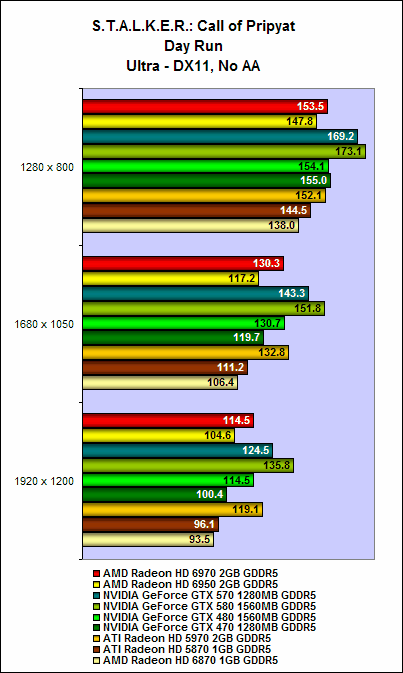 | 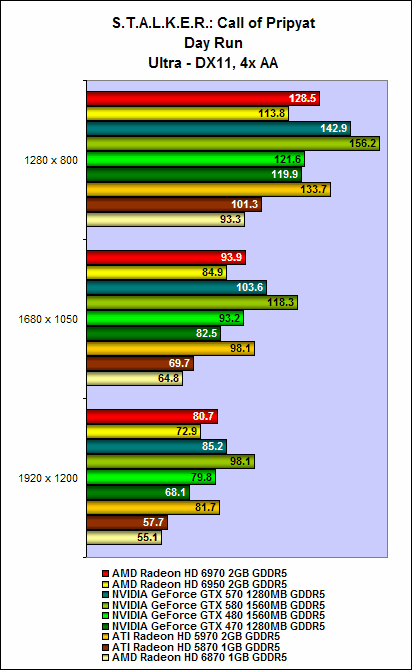 |
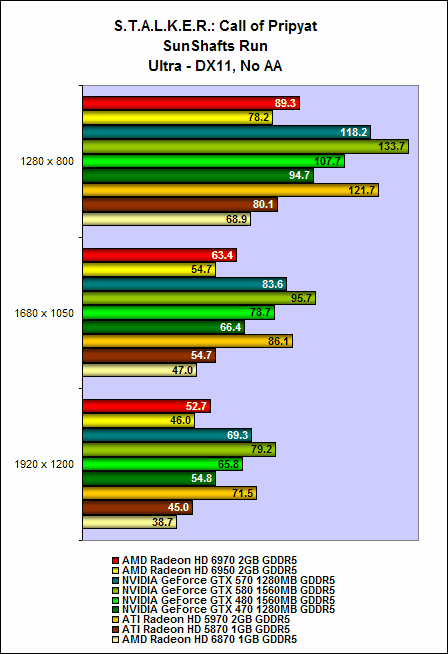 | 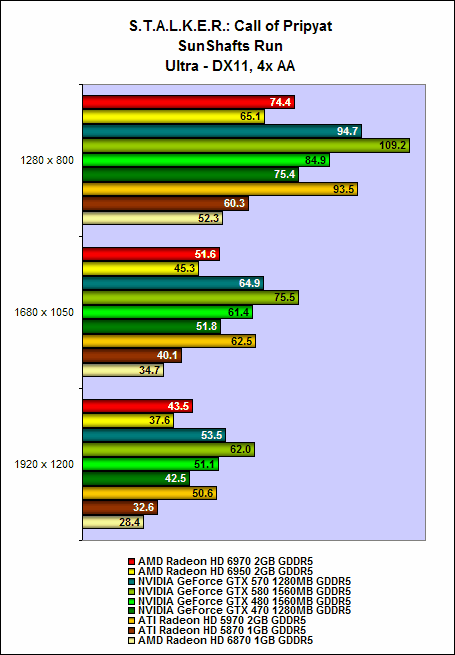 |
DirectX 10 Results
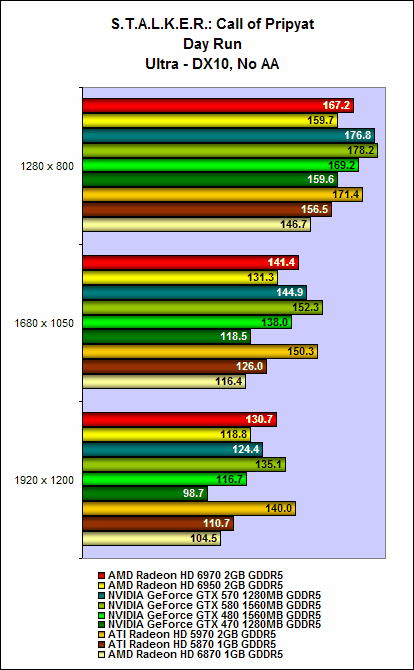 | 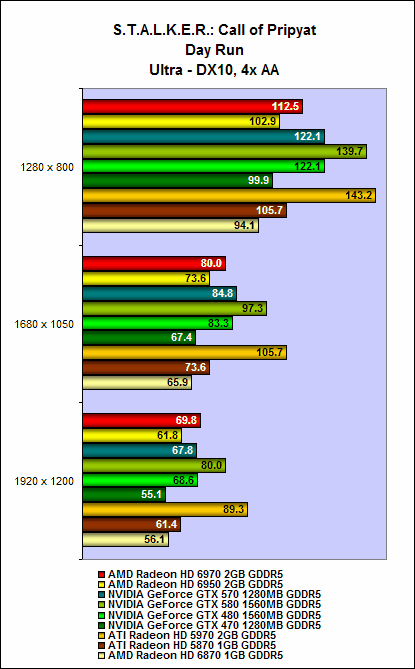 |
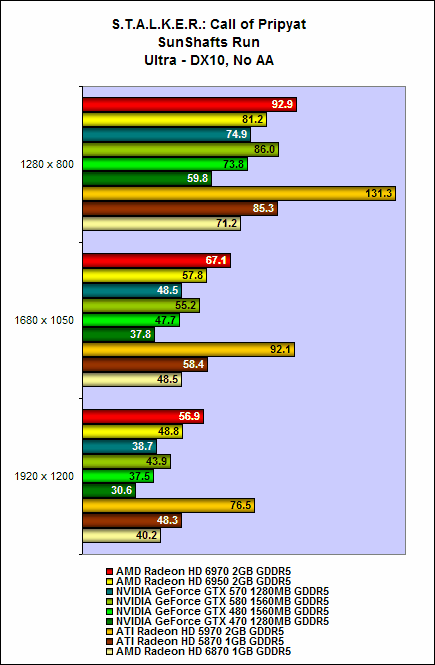 | 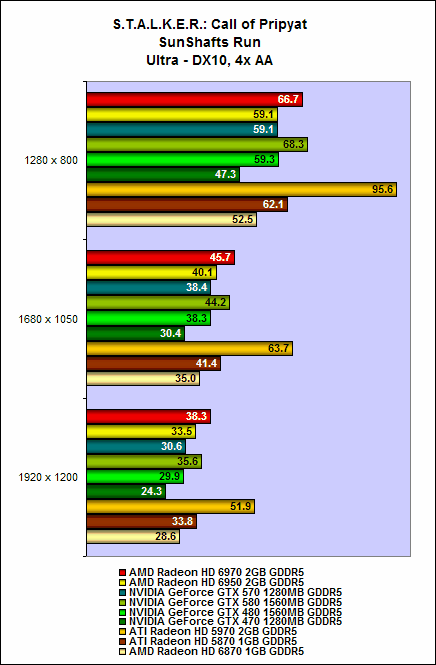 |
Temperature
NVIDIA has made great improvements in terms of cooling by introducing a custom design vapor chamber cooler to their new GeForce GTX 580 and GTX 570, and this has brought down operating temperatures of their new cards by a considerable degree. The Radeon HD 6970 and HD 6950 are not cool cards by any means but at least they are still manageable with the Radeon HD 6970 coming in at 77 degrees Celsius when measuring core temperatures, while the Radeon HD 6950 is slightly cooler at 74 degrees Celsius. Definitely an improvement over the Radeon HD 5870, but not convincing against the NVIDIA GTX 570 when you take the performance potential into consideration.

Power Consumption
The previous generation Evergreen cards were renowned for their power efficiency, but AMD seems to have let up slightly with the Radeon HD 6970 and HD 6950. The Radeon HD 6970, especially, was quite disappointing. Not only was it trounced by the GeForce GTX 570 in most of the benchmarks, it’s power draw figures were only slightly lower than the GeForce GTX 570. It would be an understatement to say that we expected better from the Radeon HD 6970. The Radeon HD 6950 fared much better, even though it was marginally faster than the old Radeon HD 5870, it still managed slightly lower readings.
Also, note that these tests were carried without PowerTune technology as the option wasn't available in our driver set. We will investigate the effects of PowerTune in a future article.

Overclocking
It’s early days for the Radeon HD 6970 and HD 6950, but we managed to get them up to pretty respectable levels. The trusty Overdrive overclocking utility that usually comes with Catalyst was missing for us, so we used MSI's popular overclocking utility for this test. And with the Radeon HD 6970, we managed to it up to 950MHz at the core and 5700MHz DDR, giving us 11512 3DMarks - an improvement of 5%. As for the Radeon HD 6950, we successfully got it to run stably at 920MHz at the core and 5200MHz DDR, which gave us 10415 3DMarks - an improvement of 11%.

Signs of Slowing Down
In terms of performance, we were a bit let down by AMD’s latest Cayman cards. Granted, Northern Islands represents only an evolutionary change for AMD, but we expected more. The Radeon HD 6950 was only about as quick as the old Radeon HD 5870, while the flagship Radeon HD 6970 was only around 10% to 15% quicker.
Compared to NVIDIA’s fearsome combination of the GeForce GTX 580 and GTX 570, the Radeon HD 6970 and HD 6950 look a bit out of their depth - especially the Radeon HD 6950. The Radeon HD 6970 could match the GeForce GTX 570 on certain benchmarks, but more often that not, the GeForce GTX 570 was the quicker of the two and by a good margin too. Looks like AMD will be banking on a dual-GPU solution to challenge NVIDIA for the title of fastest single graphics card in the near future.
Elsewhere, the Radeon HD 6970 and HD 6950 displayed good thermal characteristics, running moderately cool for cards for their calibre. However, we are a bit worried by the power draw figures we recorded with the Radeon HD 6970. Bearing in mind the Radeon HD 6970 was only about 10% quicker than the HD 6950, we were a bit surprised to see that its power draw figure at load was substantially higher.

The Radeon HD 6950 refreshes the old Radeon HD 5870, but the Radeon HD 6970 falls short of challenging NVIDIA's fearsome GeForce GTX 570 and GTX 580 duo.
Looking at price, the Radeon HD 6970 is set to launch at US$369 while the less powerful Radeon HD 6950 will command a more affordable US$299 price tag. Examining the Radeon HD 6970 first, we think its price makes it tough to recommend in face of the cheaper and faster GeForce GTX 570, which is now going for around US$349. Unless the Radeon HD 6970 with support for massive multi-monitor setups is useful to you, we think the slightly cheaper and faster GeForce GTX 570 is a better option since it is about as power hungry and hot to run as the Radeon HD 6970.
The Radeon HD 6950 at US$299, on the other hand, occupies a price bracket that faces no direct competition from NVIDIA, seeing that the GeForce GTX 470 is markedly cheaper at US$259 and also quite some ways slower. Really, one can think of the Radeon HD 6950 as a HD 5870 refreshed (which often retails a lot higher than US$300) and all things considered, this makes the Radeon HD 6950 a great card for under US$300.
Overall, however, the new Cayman parts are not as exciting as we’ve hoped. While the Radeon HD 6950 can be treated as a refreshed version of the Radeon HD 5870, the Radeon HD 6970 should really have been faster than the GeForce GTX 570. While ATI/AMD has had the upper-hand for the past year or so, the new Cayman cards haven’t been as scintillating as we’ve hoped and it seems that they are losing their momentum, and NVIDIA is slowly, but surely catching up. The next few months should be worth looking forward to as we expect even more refreshes to come about.
| 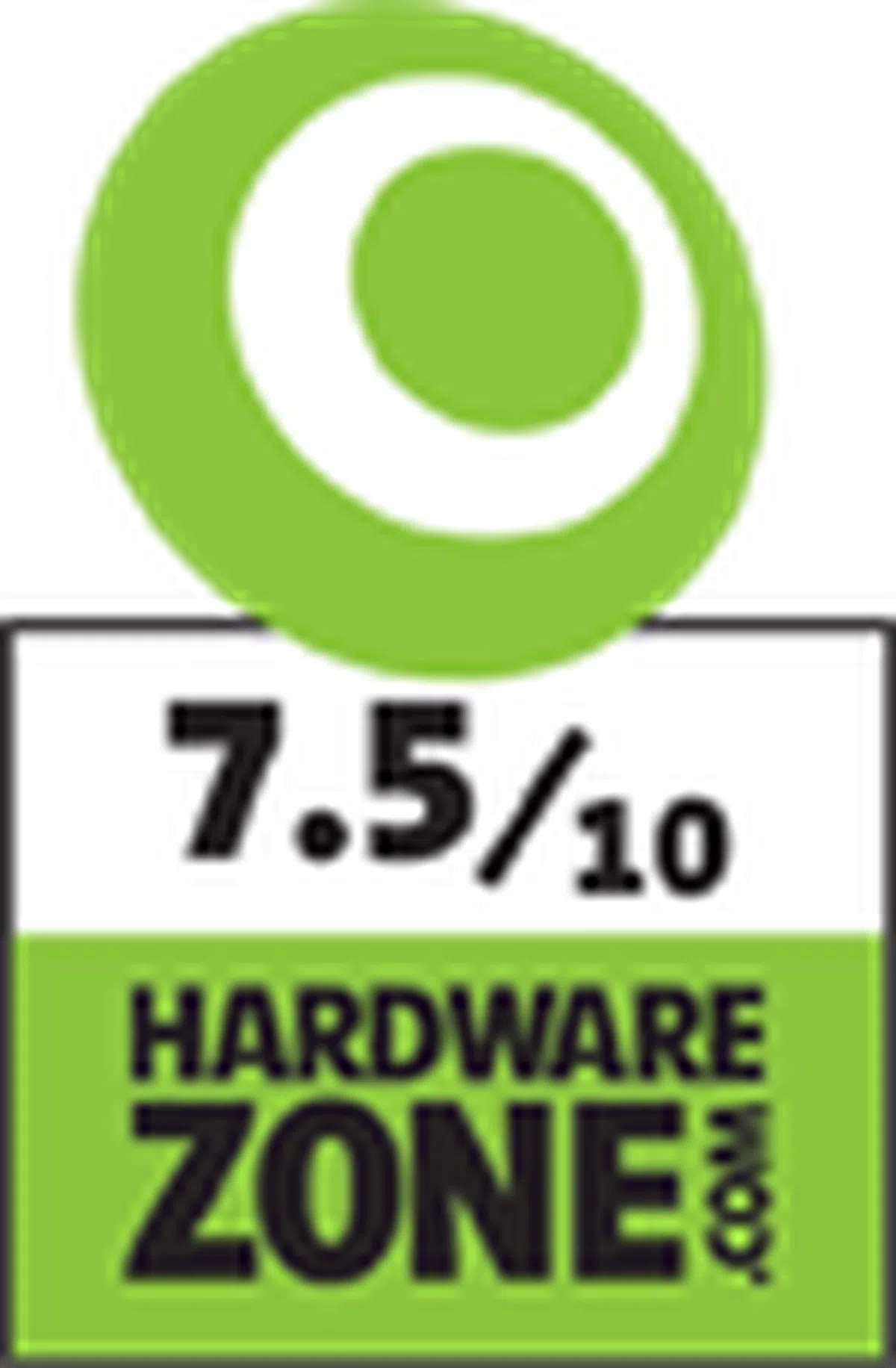 |
Our articles may contain affiliate links. If you buy through these links, we may earn a small commission.
